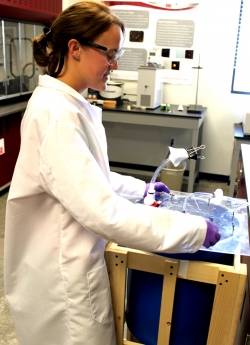From Beakers to Barrels: The Algae Bioreactor
In order to lessen the risk in developing industrial technologies for biofuel production, the project management team at Eastern Kentucky University’s Center for Renewable and Alternative Fuel Technologies (CRAFT) has adopted an incremental scale-up approach to commercialization.
One of many on-going research projects at CRAFT focuses on deriving biofuels from oil found in heterotrophic microalgae which receive their energy from glucose rather than photosynthesis via sun light. Heterotrophic algae are not grown in ponds like most algae-based biofuel programs. Instead, they are grown in bioreactors, or tanks engineered to provide the most favorable growing conditions to sustain algal life.
Amber Goff administered CRAFT’s algae research and conducted a study on the scale up of algae growth environments, going from 4L flasks to a 40L “homemade” bioreactor. The process for growing algae in a bioreactor can be compared to fermentation in food and alcohol production, and scaling up will allow lipid (oil) and algal biomass production at a much faster rate than current methods.
“We have been conducting research in a shaking incubator with flask size ranging from 250mL to 4L,” stated Goff. “While the shaking incubator provides us with a way to easily replicate a study, the bioreactor is more true to how the algae will grow in industry.” The current project uses glucose from switchgrass grown in Kentucky.
The bioreactor is a polyethylene cone-bottomed cylindrical tank, which is typically used in the aquaculture industry to grow shrimp. “We designed an air-lift system, which not only provides air but keeps the algae in suspension,” said Goff. “To keep the appropriate temperature of 28°C, we use a heating blanket on the outside of the tank.” The bioreactor can be easily drained from the bottom for harvesting. The 40L bioreactor will be used as the final growth stage for the algae, to achieve maximum lipid accumulation in the cells.
Success of the scale up will be based on lipid accumulation. Once the algae are harvested from the bioreactor the biomass will be dried, then the lipids will be extracted and finally a dry weight-to-lipid ratio will be determined. This information will be compared to data in recent literature from scientific journals. Accumulation of 55% lipids has been recorded in heterotrophic algae cells.
“In trying to scale up, we are having problems with bacterial contamination,” said Goff. “The bacteria out compete the algae and take over the growing environment, causing non-ideal growth and lipid accumulation with the algae.” The CRAFT team is currently working on a remedy for this problem.
According to Goff, “this knowledge benefits CRAFT because our ultimate goal is to produce an efficient scaled up system to use in the biodiesel industry. While producing algae in flasks is sufficient for obtaining laboratory data, we ultimately need a system that can be replicated in industry and produce millions of gallons of biodiesel.”
Concluding this initial scale up, the CRAFT team is working on making the system more efficient at producing lipids by possibly scaling up to a larger bioreactor.
Contact Information
Gary Selby
859-622-7316
Published on May 17, 2012
